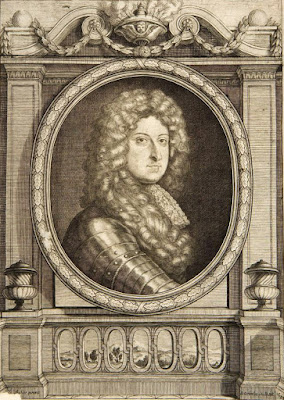 |
| Jean-Louis Lemoyne Portrait of Jacques-Rolland Moreau 1712 marble Museum of Fine Arts, Boston |
from Diary of the Cavaliere Bernini's Visit to France
Speaking of sculpture and the difficulty of making a success of it, and particularly of getting a likeness in marble, he told me a remarkable thing, which he has since repeated on many occasions – that if a man bleached his hair, his beard, his eyebrows, and, if it were possible, the pupils of his eyes and his lips, and showed himself in this state to those who were accustomed to see him every day, they would have difficulty in recognizing him. To prove it he added that the pallor which fainting brings makes a man almost unrecognizable, so that people exclaim, 'He no longer seems to be the same man.' For this reason it is extremely hard to get a likeness in marble that is all of one color. He told me something even more extraordinary, that to imitate nature in marble it may be necessary to put in that which is not there. He said something even more paradoxical, that sometimes in a marble portrait, in order to represent the dark which some people have around their eyes, one must hollow out the marble, in this way obtaining the effect of color and supplementing, so to speak, the art of sculpture, which cannot give color to things. So naturalism is not the same as imitation. . . . M. de Lionne mentioned portraits in bronze. The Cavaliere said it was an even less suitable material than marble because it darkened. If it were covered in gilt, the luster made reflections which prevented one from observing the delicacy and beauty of the portrait; on the other hand, nine or ten years after marble had been worked, it acquired an indescribable softness of tone and in the end became the color of flesh."
– Paul Fréart do Chantelou (1665), translated by Margery Corbett (1985)
"Resemblance, character, costume, are the three requisites of portrait: the first distinguishes, the second classifies, the third assigns place and time to an individual."
 |
| Jean-Baptiste de Poilly after Joseph Vivien Portrait of artist Corneille van Clève ca. 1714 etching Teylers Museum, Haarlem |
 |
| Dirk Helmbreker Study of a Woman before 1696 drawing Musée du Louvre |
 |
| Pietro Dandini Portrait of Francesco Redi ca. 1695 oil on canvas Palazzo della Fraternità dei Laici, Arezzo |
 |
| Simon Gribelin after D. Vautier Portrait of William Cavendish, 1st Duke of Devonshire ca. 1680-89 engraving Harvard Art Museums |
 |
| Willem Wissing Portrait of Princess Mary, elder daughter of James II ca. 1685 oil on canvas Congregational Memorial Hall, London |
 |
| Mary Beale Portrait of Charles Beale, the artist's husband ca. 1680 oil on bed ticking West Suffolk Council, Bury St Edmunds |
 |
| John Michael Wright Portrait of Sir Neil O'Neill 1680 oil on canvas Tate Britain |
 |
| Pietro della Vecchia Head of a Landsknecht before 1678 oil on canvas Palazzo dei Diamanti, Ferrara |
 |
| Giovanni Bernardo Carboni Portrait of a Gentleman ca. 1675 oil on canvas Indianapolis Museum of Art |
 |
| Henri Gascars Portrait of Barbara Villiers, Countess of Castlemaine and Duchess of Cleveland ca. 1670 oil on canvas National Trust, Hatchlands, Surrey |
 |
| Peter Lely Portrait of Lady Margaret Murray, Lady Maynard ca. 1670-75 oil on canvas National Trust, Ham House, London |
 |
| Peter Lely Portrait of the Honourable Elizabeth Alington, Lady Seymour of Trowbridge ca. 1663-65 oil on canvas National Trust, Petworth House, Sussex |
 |
| Peter Lely Portrait of Sir William Compton ca. 1655-60 oil on canvas National Trust, Ham House, London |
 |
| Peter Lely Portrait of Josceline Percy, Lord Percy 1658 oil on canvas Walker Art Gallery, Liverpool |
 |
| Michel Corneille the Younger Head Study after the Antique ca. 1660 drawing Musée du Louvre |
"Resemblance, character, costume, are the three requisites of portrait: the first distinguishes, the second classifies, the third assigns place and time to an individual."
– Henry Fuseli, from Aphorisms on Art (1818)